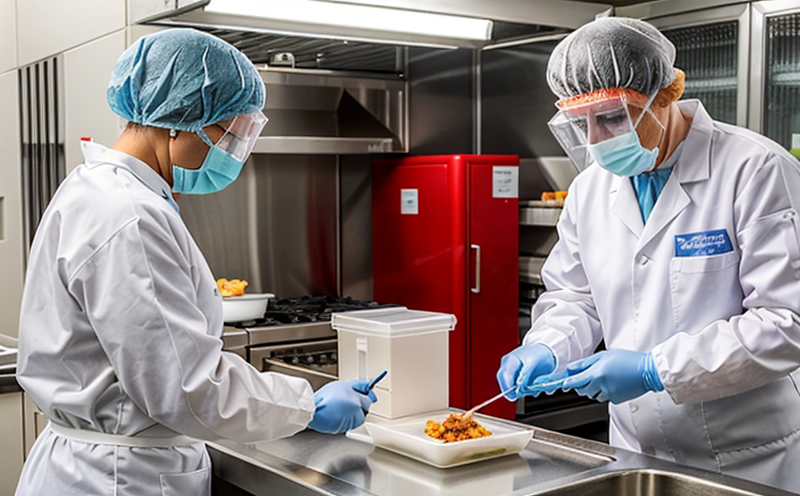USP Validation of Alternative Viral Detection Methods in Food Testing
The United States Pharmacopeia (USP) [1] monograph Validation of Alternative Viral Detection Methods for Foods (USP ) provides a standardized framework for the validation and qualification of alternative methods used in detecting foodborne viruses. This service ensures that laboratories can reliably assess new methods, ensuring they meet stringent quality standards before being implemented in commercial environments.
This service is particularly crucial as it addresses the growing demand for efficient, accurate, and cost-effective detection techniques across the global food industry. Traditional methods often fail to provide sufficient sensitivity or specificity, leading to potential delays in identifying contaminants. USP offers a robust approach that validates alternative methods by comparing them against internationally recognized standards such as ISO 17025.
The process involves several critical steps: selecting appropriate reference materials, establishing acceptance criteria based on USP guidelines, and performing comparative studies using standardized protocols. This ensures the method's reliability in real-world applications where contamination levels can vary widely.
Our team specializes in this area by leveraging advanced analytical techniques such as real-time PCR, next-generation sequencing, and enzyme-linked immunosorbent assays (ELISAs). These tools allow us to assess not only the performance of a new method but also its robustness under various conditions. By doing so, we ensure that any alternative approach meets or exceeds current standards.
One key aspect of this service is ensuring compliance with relevant regulations and guidelines. For instance, adherence to ISO 17025 ensures that laboratories maintain high levels of proficiency and consistency in their testing processes. Additionally, our team stays updated on the latest developments within regulatory bodies like USP, FDA, and WHO.
Another essential component of this service is its application across different types of food products. Whether it’s fresh produce, processed meats, dairy goods, or packaged items, our expertise covers a broad spectrum of matrices commonly associated with potential viral contamination. This versatility allows us to tailor tests according to specific product characteristics and expected outcomes.
Our approach also emphasizes sustainability by promoting the use of fewer resources during validation processes while maintaining accuracy and efficiency. By minimizing waste and optimizing sample sizes, we contribute positively towards environmental conservation efforts within the laboratory setting.
In summary, our USP validation service plays a pivotal role in advancing food safety practices globally. Through rigorous testing procedures aligned with international standards, we help manufacturers adopt more effective viral detection methods that enhance product quality and consumer trust.
Applied Standards
| Standard | Description |
|---|---|
| USP [1] 2253 | Validation of Alternative Viral Detection Methods for Foods |
| ISO 17025 | International standard ensuring competence and proficiency in testing laboratories. |
| EN ISO/IEC 17025 | European equivalent of ISO 17025 applicable to various fields including food safety.|
| ASTM E2934-20 | American Society for Testing and Materials standard addressing validation procedures for alternative methods.
The application of these standards ensures that the testing methodologies employed are consistent, reproducible, and meet regulatory requirements. Compliance with such stringent guidelines is essential for maintaining credibility within both domestic and international markets.
Environmental and Sustainability Contributions
Incorporating sustainability into our USP validation service helps reduce the environmental footprint associated with food testing. By optimizing resource usage, minimizing waste generation, and adopting energy-efficient practices throughout the laboratory environment, we contribute positively towards global sustainability goals.
Specifically, this involves reducing the amount of reagents used during experiments through careful planning and efficient sample preparation techniques. Additionally, by implementing digital record-keeping systems instead of paper-based documentation, we significantly lower our carbon emissions associated with printing and archiving materials.
The use of advanced analytical instruments designed to minimize power consumption further supports our commitment to environmental stewardship. Furthermore, our collaborative efforts with clients in developing sustainable solutions for food testing demonstrate how innovation can drive positive change within the industry.
Through these measures, we not only enhance operational efficiency but also play a vital role in fostering an eco-friendly approach that benefits all stakeholders involved in the food supply chain.
Competitive Advantage and Market Impact
The implementation of USP -compliant alternative viral detection methods offers significant competitive advantages for companies operating within the food sector. By adhering to this standard, businesses can differentiate themselves by offering more reliable and efficient solutions that meet current and future regulatory demands.
Early adoption of validated alternative methods allows organizations to stay ahead of competitors who may still rely on older technologies or less rigorous validation processes. This ensures a higher degree of confidence among consumers regarding the safety and quality of products offered.
The ability to quickly identify and respond to emerging threats such as novel pathogens enhances operational resilience, reducing risks associated with recalls or supply disruptions. Moreover, compliance with international standards like USP opens doors to exporting goods into markets that have stringent import requirements regarding food safety practices.
Achieving recognition for excellence in this field also attracts top talent and fosters partnerships with other leading firms, thereby strengthening overall market position. In essence, embracing advanced validation protocols is not just about meeting regulatory expectations; it’s an investment in long-term success and growth within the competitive landscape of global food safety.





